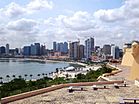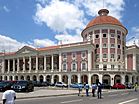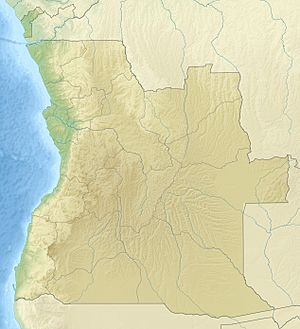Luanda facts for kids
Quick facts for kids
Luanda
|
|
|---|---|
|
Capital city
|
|
|
Top: Agostinho Neto Memorial; National Assembly of Angola; Sonangol HQ; middle: view of Luanda; bottom: Bay of Luanda; Bank of Angola HQ.
|
|
| Country | Angola |
| Province | Luanda |
| Founded | 1576 |
| Area | |
| • Capital city | 116 km2 (45 sq mi) |
| • Metro | 1,876 km2 (724 sq mi) |
| Elevation | 6 m (20 ft) |
| Population
(2020)
|
|
| • Capital city | 2,571,861 |
| • Density | 22,170/km2 (57,420/sq mi) |
| • Metro | 8,330,000 |
| • Metro density | 4,440/km2 (11,500/sq mi) |
| 2019 | |
| Time zone | +1 |
| HDI (2019) | 0.697 Medium |
Luanda is the capital and largest city in Angola. It is Angola's primary port, and its major industrial, cultural and urban centre. Located on Angola's northern Atlantic coast, Luanda is Angola's administrative centre, its chief seaport, and also the capital of the Luanda Province. Luanda and its metropolitan area is the most populous Portuguese-speaking capital city in the world and the most populous Lusophone city outside Brazil, with over 8.3 million inhabitants in 2020 (a third of Angola's population).
Among the oldest colonial cities of Africa, it was founded in January 1576 as São Paulo da Assunção de Loanda by Portuguese explorer Paulo Dias de Novais. The city served as the centre of the slave trade to Brazil before its prohibition. At the start of the Angolan Civil War in 1975, most of the white Portuguese left as refugees, principally for Portugal. Luanda's population increased greatly from refugees fleeing the war, but its infrastructure was inadequate to handle the increase. This also caused the exacerbation of slums, or musseques, around Luanda. The city is undergoing a major reconstruction, with many large developments taking place that will alter its cityscape significantly.
The industries present in the city include the processing of agricultural products, beverage production, textile, cement, new car assembly plants, construction materials, plastics, metallurgy, cigarettes and shoes. The city is also notable as an economic centre for oil, and a refinery is located in the city. Luanda has been considered one of the most expensive cities in the world for expatriates. The inhabitants of Luanda are mostly members of the ethnic group of the Ambundu, but in recent times there has been an increase of the number of the Bakongo and the Ovimbundu. There exists a European population, consisting mainly of Portuguese. Luanda was the main host city for the matches of the 2010 African Cup of Nations.
Images for kids
-
São Miguel Fortress, founded in 1576 by Paulo Dias de Novais, today hosts the Armed Forces Museum.
-
Portuguese Armed Forces marching in Luanda during the Portuguese Colonial Wars (1961–74).
-
President José Eduardo dos Santos with President of Brazil Dilma Rousseff at the Presidential Palace in 2011.
-
Statue of Ana de Sousa.
See also
 In Spanish: Luanda para niños
In Spanish: Luanda para niños

































